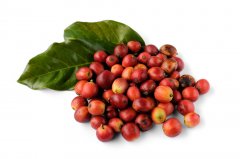Introduction to the treatment process of raw coffee beans Coffee trees bear fruit several times a year
When the coffee berries are ripe, they are usually harvested by manual picking. In some places, only the fully ripe berries are picked, while others are all picked from a single branch. The former is called "handpicked" and the latter is called "strip-picking". Because the ripening time of coffee berries is not consistent, so the harvest is likely to be divided into several times, the duration will be very long, so harvesting is also the largest part of manpower investment.
The harvested coffee berries need further treatment, usually in two ways.
One is water washing, which is popular in Central America and parts of Africa; freshly harvested coffee berries separate the peel from the beans manually or mechanically, and then soak in water for 2 to 3 days. In this way, the pulp and sticky matter attached to the coffee beans will be removed. Then comes the cleaning and drying process, which can be done in the natural sun or by machine.
One is: solarization, which is more economical in Brazil and most African countries. After removing twigs and other debris, the coffee berries are spread out in the sun for 2 to 3 weeks, turning repeatedly to make the berries drier until the berries fall off the coffee beans.
When the water content of the coffee beans is reduced to about 13%, the coffee beans will be bagged and cooked in the warehouse for 1 to 3 months.
Finally, it can be sold.
Structure editing
1:center cut
Middle line
2:bean (endosperm) coffee beans
3:silver skin (testa, epidermis) silver leather
4:parchment (hull, endocarp) fruit shell
5:pectin layer pectin
6:pulp (mesocarp) peel
7:outer skin (pericarp, exocarp) exocarp

Important Notice :
前街咖啡 FrontStreet Coffee has moved to new addredd:
FrontStreet Coffee Address: 315,Donghua East Road,GuangZhou
Tel:020 38364473
- Prev

About the certification of coffee beans, what is 4C coffee beans? imported high-quality coffee.
4C verification link brief answer 1. How do you know if any behavior in the grower and other supply chains is in compliance with the 4C code of conduct? The 4C verification process begins with a self-assessed 4C unit with corresponding organization charts of all business partners and units, which is the basis for field verification.
- Next

What is the coffee standard of cocoa frog coffee certified by UTZ Certified quality coffee?
The implementing rules for the Certification of quality Coffee (Tea / Cocoa) is a set of internationally recognized standards, including economic, social and environmental standards for responsible coffee (tea / cocoa) production. Producers who comply with these rules (plantation owners or small farmers' groups) may seek certification. Chain of custody requirements is a set of management and technical rules that highly guarantee high-quality certified coffee
Related
- Detailed explanation of Jadeite planting Land in Panamanian Jadeite Manor introduction to the grading system of Jadeite competitive bidding, Red bid, Green bid and Rose Summer
- Story of Coffee planting in Brenka region of Costa Rica Stonehenge Manor anaerobic heavy honey treatment of flavor mouth
- What's on the barrel of Blue Mountain Coffee beans?
- Can American coffee also pull flowers? How to use hot American style to pull out a good-looking pattern?
- Can you make a cold extract with coffee beans? What is the right proportion for cold-extracted coffee formula?
- Indonesian PWN Gold Mandrine Coffee Origin Features Flavor How to Chong? Mandolin coffee is American.
- A brief introduction to the flavor characteristics of Brazilian yellow bourbon coffee beans
- What is the effect of different water quality on the flavor of cold-extracted coffee? What kind of water is best for brewing coffee?
- Why do you think of Rose Summer whenever you mention Panamanian coffee?
- Introduction to the characteristics of authentic blue mountain coffee bean producing areas? What is the CIB Coffee Authority in Jamaica?

